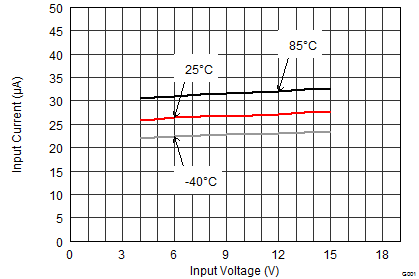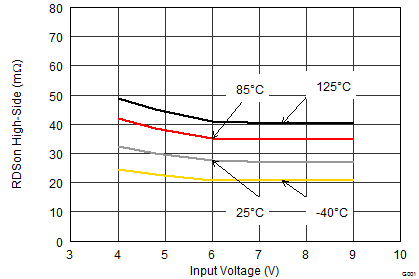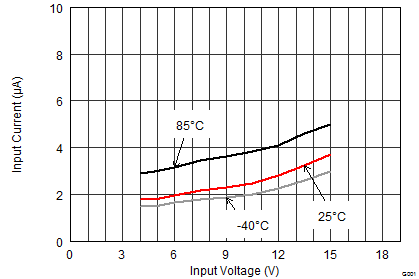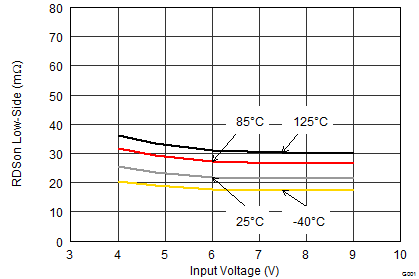SLVSBB8B August 2014 – May 2017 TPS62180 , TPS62182
PRODUCTION DATA.
- 1 Features
- 2 Applications
- 3 Description
- 4 Revision History
- 5 Device Comparison Table
- 6 Pin Configuration and Functions
- 7 Specifications
-
8 Detailed Description
- 8.1 Overview
- 8.2 Functional Block Diagram
- 8.3 Feature Description
- 8.4
Device Functional Modes
- 8.4.1 Pulse Width Modulation (PWM) Operation
- 8.4.2 Power Save Mode (PSM) Operation
- 8.4.3 Minimum Duty Cycle and 100% Mode Operation
- 8.4.4 Automatic Efficiency Enhancement (AEE)
- 8.4.5 Phase-Shifted Operation
- 8.4.6 Current Limit, Current Balancing, and Short Circuit Protection
- 8.4.7 Tracking
- 8.4.8 Operation with Fixed VOUT
- 9 Application and Implementation
- 10Power Supply Recommendations
- 11Layout
- 12Device and Documentation Support
- 13Mechanical, Packaging, and Orderable Information
Package Options
Mechanical Data (Package|Pins)
- YZF|24
Thermal pad, mechanical data (Package|Pins)
Orderable Information
7 Specifications
7.1 Absolute Maximum Ratings(1)
| MIN | MAX | UNIT | ||
|---|---|---|---|---|
| Pin voltage range(2) | VIN1, VIN2 | –0.3 | 17 | V |
| EN, PG | –0.3 | VIN + 0.3 | V | |
| SW1, SW2, (DC) | –0.3 | VIN + 0.3 | V | |
| SW1, SW2, (AC, less than 10ns)(3) | –2 | 24.5 | ||
| SS/TR | –0.3 | VIN + 0.3, but ≤ 7 |
V | |
| FB, VO | –0.3 | 7 | V | |
| Power good sink current | PG | 10 | mA | |
| Operating junction temperature range | TJ | –40 | 150 | °C |
| Storage Temperature Range | Tstg | –65 | 150 | °C |
(1) Stresses beyond those listed under Absolute Maximum Ratings may cause permanent damage to the device. These are stress ratings only, which do not imply functional operation of the device at these or any other conditions beyond those indicated under Recommended Operating Conditions. Exposure to absolute-maximum-rated conditions for extended periods may affect device reliability.
(2) All voltages are with respect to network ground pin.
(3) While switching.
7.2 ESD Ratings
| MIN | MAX | UNIT | ||
|---|---|---|---|---|
| VESD(1) | Human Body Model (HBM) ESD stress voltage(2) | –1 | 1 | kV |
| Charge device model (CDM) ESD stress voltage | –0.5 | 0.5 | ||
(1) Electrostatic discharge (ESD) to measure device sensitivity and immunity to damage caused by assembly line electrostatic discharges in to the device.
(2) Level listed above is the passing level per ANSI, ESDA, and JEDEC JS-001. JEDEC document JEP155 states that 500-V HBM allows safe manufacturing with a standard ESD control process.
7.3 Recommended Operating Conditions
| MIN | TYP | MAX | UNIT | ||
|---|---|---|---|---|---|
| Supply voltage range, VIN | 4 | 15 | V | ||
| Output voltage range, VOUT | 0.9 | 6 | V | ||
| Maximum Output current, IOUT(max) | 0.9V ≤ VOUT ≤ 3.3V | 6 | A | ||
| 3.3V < VOUT | 6 | ||||
| Operating junction temperature, TJ | –40 | 125 | °C | ||
7.4 Thermal Information
| THERMAL METRIC(1) | TPS6218x | UNIT | |
|---|---|---|---|
| YZF (24 PINS) | |||
| RθJA | Junction-to-ambient thermal resistance | 61.5 | °C/W |
| RθJCtop | Junction-to-case (top) thermal resistance | 0.3 | °C/W |
| RθJB | Junction-to-board thermal resistance | 10.1 | °C/W |
| ψJT | Junction-to-top characterization parameter | 0.1 | °C/W |
| ψJB | Junction-to-board characterization parameter | 10.1 | °C/W |
| RθJCbot | Junction-to-case (bottom) thermal resistance | n/a | °C/W |
(1) For more information about traditional and new thermal metrics, see the IC Package Thermal Metrics application report, SPRA953.
7.5 Electrical Characteristics
Over operating junction temperature range (TJ = –40°C to +125°C) and VIN = 4 V to 15 V.Typical values at VIN = 12 V and TJ = 25°C (unless otherwise noted).
| PARAMETER | TEST CONDITIONS | MIN | TYP | MAX | UNIT | ||
|---|---|---|---|---|---|---|---|
| SUPPLY | |||||||
| VIN | Input voltage range | 4 | 15 | V | |||
| IQ | Operating quiescent current | EN = High, IOUT = 0 mA, Device not switching, (TJ = –40°C to +85°C) |
28 | 55 | µA | ||
| ISD | Shutdown current | EN = Low (≤ 0.3 V), (TJ = –40°C to +85°C) | 2.8 | 15 | µA | ||
| VUVLO | Undervoltage lockout threshold (1) | Falling input voltage | 3.5 | 3.6 | 3.7 | V | |
| Hysteresis | 300 | mV | |||||
| TSD | Thermal shutdown | Rising junction temperature | 160 | °C | |||
| Hysteresis | 20 | ||||||
| CONTROL (EN, SS/TR, PG) | |||||||
| VH_EN | High-level input threshold voltage (EN) | 0.97 | 1 | 1.03 | V | ||
| VL_EN | Low-level input threshold voltage (EN) | 0.87 | 0.9 | 0.93 | V | ||
| ILKG_EN | Input leakage current (EN) | EN = VIN or GND | 0.01 | 1.2 | µA | ||
| ISS/TR | SS/TR pin source current | 4.5 | 5 | 5.5 | µA | ||
| VTH_PG | Power good threshold voltage | Rising (%VOUT) | 94% | 96% | 98% | ||
| Falling (%VOUT) | 90% | 92% | 94% | ||||
| VOL_PG | Power good output low voltage | IPG= -2 mA | 0.3 | V | |||
| ILKG_PG | Input leakage current (PG) | 1 | 100 | nA | |||
| POWER SWITCH | |||||||
| RDS(ON) | High-side MOSFET ON-resistance | VIN = 7.5 V | Phase 1 | 27 | 65 | mΩ | |
| Phase 2 | |||||||
| Low-side MOSFET ON-resistance | Phase 1 | 21 | 45 | mΩ | |||
| Phase 2 | |||||||
| ILIM | High-side MOSFET current limit | Each phase, VIN = 7.5 V | 4.0 | 4.7 | 5.5 | A | |
| TPSD | Phase shift delay time | Phase 2 after Phase 1, PWM mode | 250 | ns | |||
| OUTPUT | |||||||
| VREF | Internal reference voltage | 0.792 | 0.8 | 0.808 | V | ||
| ILKG_FB | Input leakage current (FB) | VFB = 0.8 V | 1 | 100 | nA | ||
| RDISCHARGE | Output discharge resistance | EN = Low | 60 | Ω | |||
| VOUT | Output voltage range (TPS62180) | VIN ≥ VOUT | 0.9 | 6 | V | ||
| Output voltage (TPS62182) | 3.3 | V | |||||
| Feedback voltage accuracy (TPS62180)(2) |
PWM Mode, VIN ≥ VOUT + 1 V | –1% | 1% | ||||
| Power Save Mode, VOUT = 3.3 V, Iload ≥ 1 mA, L = 1 µH, COUT = 2 x 47 µF, (TJ = –40°C to +85°C) |
–1% | 2% | |||||
| Power Save Mode, VOUT = 1.8 V, Iload ≥ 1 mA, L = 1 µH, COUT = 4 x 47 µF, (TJ = –40°C to +85°C) |
|||||||
| Power Save Mode, VOUT = 0.9 V, Iload ≥ 1 mA, L = 1 µH, COUT = 4 x 47 µF, (TJ = –40°C to +85°C) |
–1% | 3% | |||||
| Output voltage accuracy (TPS62182)(2) |
PWM Mode, VIN ≥ VOUT + 1 V | –1% | 1% | ||||
| Power Save Mode, Iload ≥ 1 mA, L = 1 µH, COUT = 2 x 47 µF, (TJ = –40°C to +85°C) |
–1% | 2% | |||||
| Load regulation | VOUT = 3.3 V, PWM Mode operation | 0.04 | %/A | ||||
| Line regulation | 4 V ≤ VIN ≤ 15 V, VOUT = 3.3 V, IOUT = 4 A | 0.01 | %/V | ||||
| tHICCUP | Hiccup on time | 0.9 | ms | ||||
| Hiccup off time | 5 | ||||||
(1) The minimum VIN value of 4 V is not violated by UVLO threshold and hysteresis variations.
(2) The accuracy in Power Save Mode can be improved by increasing the output capacitor value, reducing the output voltage ripple.
7.6 Typical Characteristics



